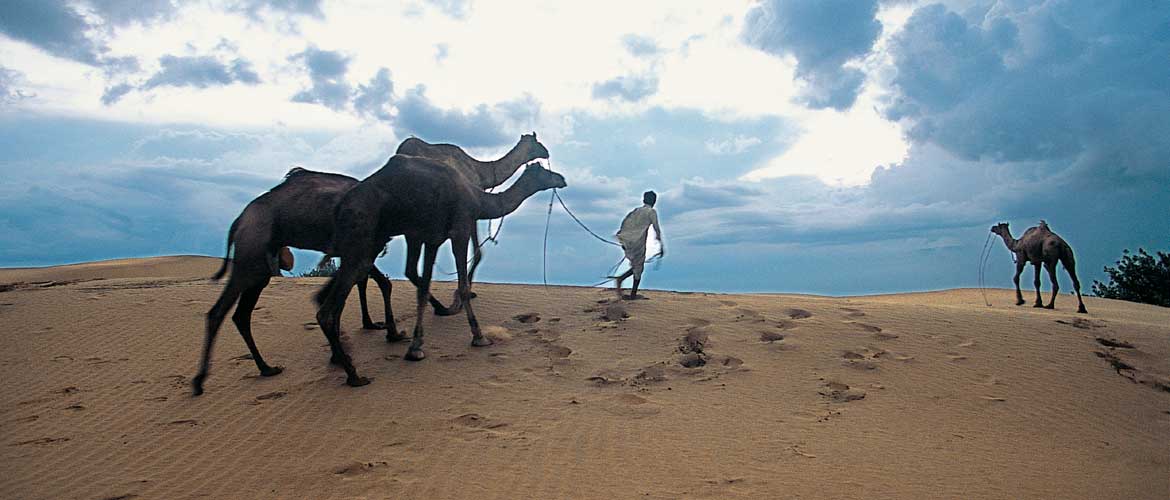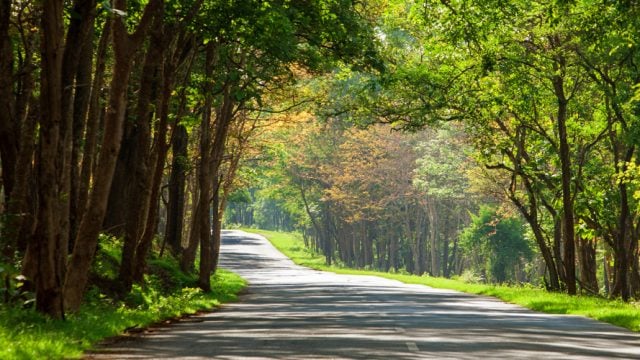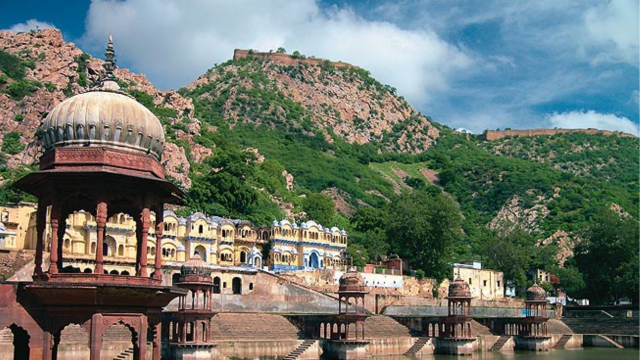The drizzle has stopped. The wind picks up, and the sand joyously soars on it,
The camels and their patrons have disappeared along with the sun, leaving us to gape wondrously at the desolate tract stretching to the horizon and beyond.
It’s wet and chilly in the Great Indian Desert! And then we notice the empty expanse slowly coming to life. A part of the desert moves, and then another. There are two of them or may be a herd, we are not sure – light-chestnut coloured ante-lopes and chinkara merging with the colour of their surroundings.
A while later, a rustle in the bushes behind makes us turn back, just in time to catch a fleeing apparition with a white-tipped bushy tail, a distinctive feature of the desert fox. Then, another fox crosses our path.
We are in the sand dunes close to Khuri village on the edge of the Desert National Park. The drive from Jaisalmer till here has been hard and rocky. Yet, the first sight of the dunes is picture-perfect, like a painting with perfectly contoured shadows of ripples and undulating crests. It is easy to see how deserts can be one of the most incredibly beautiful, thrilling, eerie, treacherous and inhospitable places on earth, all at the same time. And it’s easy to see why people flock to gaze at them, to get their photographs clicked with camels in the foreground and sunset in the background. It is an out-of-this-world experience. We are so enchanted with the sandy knolls that we don’t even notice that because of the rains, the romantic ‘sunset on the dune’ experience hasn’t even taken off.
The Wildlife Department officials tell us that the best way to see wildlife, especially the rare great Indian bustard, in this national park, is to go to Sudashri, about 55km southwest of Jaisalmer. Early next morning, our jeep hurries on the deserted pebbly flats and the brownish piedmont plateau past the famous sand dunes near Sam, where we stop for just enough time to take in the red sun rising over the clean golden sand. Some dunes spill onto the road, the wilderness attempting to reclaim the tract. We turn off the road, which goes till the Indo-Pak border and, in earlier times, would have led into Sindh.
Sudashri is a 2,000-acre area enclosed with barbed wire and, at first sight, the enclosure seems like an unlikely place to visit for a wildlife experience – patches of clumpy sewan grass, a few shrubs and, an occasional tree, mainly acacia. Plus six camels wandering around, grazing busily. We are offered a choice between walking and riding a camel cart to traverse the 4-km-long trail. We choose the unknown entity – the camel cart – and immediately, the process of assembling it begins. One of the wandering camels, Babloo, is fetched. The cart – actually a wooden plank on two wheels – is hitched to him and a mattress placed on it as a favour to us city dwellers. We are to be accompanied by Uma Ram, our guide, who seems more excited than us about the prospect of spotting the great Indian bustard. He considers it a great privilege to be able to see this bird, which is nearing extinction.
As we make ourselves comfortable on the cart, we slowly become aware of our surroundings. That twig is, in fact, a pallid harrier, bobbing its head as it walks on the ground; there is an Indian robin on a shrub; the flock above is sandgrouse. There are a couple of chinkaras behind that clump of bushes. We stop often and binoculars are passed around. The desert is teeming with life. We realise that the sparseness of the vegetation provides an excellent wildlife-viewing opportunity. There is far less occasion for the animals to disappear than there would be in a heavily-wooded jungle. The possibilities to observe animals and birds are better, even when they have taken shelter.
And then we see our first great Indian bustard. There are two of the tall birds, greyish in appearance, walking away from us slowly and elegantly. Females, we are informed. And then another one, a female again. Occasionally, they pick something from the ground, maybe a berry or an insect and steadily keep moving from us. But Uma Ram is trying to draw our attention to a tree further away, under which a chinkara is standing and gazing at us. Realising that we have noticed it, the chinkara swiftly withdraws behind the tree, but is still visible. By the time we turn again, the bustards have covered quite a distance and disappeared behind shrubs.
However, we are lucky. Uma Ram has spotted another bustard – this time a male (it’s taller), and what fortune, there is not just one but two, three and why, a fourth too. One of the big birds is fearless and stands its ground, giving us the opportunity to take a good look, while the rest start walking away. Now they are behind a tree, but soon emerge on the other side. We are transfixed, but are suddenly alerted by the action in a nearby bush. A small and hairy creature darts away from us – a desert fox. We also spot the tawny eagle, the Eurasian owl, the common buzzard and the red-backed shrike.

I learn that most visitors see three or four bustards. A sighting of seven or eight is considered very good. But we are moving well beyond all these benchmarks. Uma Ram is avidly counting, and by the thirteenth spotting he is excited beyond words – and more are still crossing our path. Once or twice, he even ‘spots’ bustards in places where we can only make out the vegetation. By the time it’s sunny and we end our excursion, Uma Ram has counted 21, and we have seen 17 or 18. This is a record of sorts. Nobody at Sudashri remembers anyone seeing so many great Indian bustards in a single day.
About Desert National Park
An area of 3,162sq km in the desert was declared a sanctuary in 1980 to preserve its fascinating and fragile habitat. There are 72 villages within the park. Some enclosures of barbed wire, with water holes, have been created, to which the villagers and their cattle are denied access. This is meant to preserve the grasslands so that they can become wildlife enclaves. Sudashri is the most well-maintained of these enclaves and the best place to see the fauna.
ORIENTATION
It’s best to visit the park from Jaisalmer. The park lies to the southwest of the city. The villages of Sam and Khuri, easily accessible from Jaisalmer, are at the edge of the park. Sam is 45km west of Jaisalmer and Sudashri is 10km southeast of Sam. Khuri is 40km southwest of Jaisalmer and Sudashri is about 8km further ahead, to the northwest. To visit the park, you need a permit from the office of the Deputy Director, Desert National Park, Khuri Road, Jaisalmer (Tel: 02992-252489). Payments have to be made in advance.
◆Permit fee Indians Rs.50, Foreigners Rs.300 Timings 10.00am–5.00pm, interrupted by a lunch (usually 1.30–2.00pm) Vehicle fee Rs.200 Guide fee Rs.200 Camera Still free; Video Rs.200
THINGS TO SEE AND DO
The two biggest draws at the park are the great Indian bustard and the chinkara. The best place to see them as well as other birds and animals is Sudashri. From Jaisalmer, there are two, almost equidistant routes to Sudashri – via Sam or via Khuri. As this is a military area, the roads are well-maintained and generally free of traffic; you can make the journey in 1.5hrs. A jeep is ideal for these roads and costs about ₹1,500 for a 4-hour-long trip and ₹2,400 for a day trip.
Desert Safari
There is a forest department post at Sudashri and the personnel stay in a few huts within the fencing. One of the gentlemen will act as your guide on the 3 to 4-km-long circuit. You can either walk it or opt for a camel cart (₹700 for about three hours). Morning is the ideal time and it’s advisable to be there by sunrise. You can easily spend three to four hours on the walk, depending on how hot it gets. Alternatively, you can arrive in the afternoon, about three or four hours before sunset.
Dunes and wildlife
A round of the sand dunes is not to be missed. The best places to see the dunes are in the villages of Sam and Khuri, located at the edge of the sanctuary. Take a jeep from Jaisalmer (around Rs.1,500, depending upon the time you want to spend there) and arrive in time for the sunrise or the sunset. A short camel ride on the dunes costs about Rs.250–300.
Birds found here include sand-grouse, partridge, bee-eater, dove and bulbul. The demoiselle cranes and common cranes arrive in winter. Amongst the mammals, the chinkara is easily spotted. Chinkara, or Gazella bennittii, is the smallest Asiatic antelope. The other notable inhabi-tants are the desert fox, desert cat, monitor lizard, spiny-tailed lizard, sandfish and saw-scaled viper. Jaipur-based naturalist and Bombay Natural History Society conservationist Manoj Kulshrestha arranges field tours in the park. Contact him at Sneh Deep, B-33, Sethi Colony, Near Transport Nagar, Jaipur; Tel: 0141-2604570, Cell: 09314880887.
WHERE TO STAY
To visit Desert National Park, you should base yourself at Jaisalmer, where there are plenty of hotels. There are a number of options at Khuri, but it’s best to do a day trip to Sudashri. It’s also possible to spend a night or two in Sam or Khuri during the high season – October to February. However, you will need to book a jeep from Jaisalmer itself. Many travel companies such as Ganesh Travels (Tel: 02992-250138, Cell: 0992928 0777), at Jaisalmer and Sahara Travels (Gopa Chowk, Tel: 252609) offer an evening to morning package at the Sam dunes, comprising transport, camel ride, dance, dinner, night stay in a tent for two and breakfast, all in the range of ₹2,500–5,000 per head. The RTDC office (Tel: 252406) arranges accommodation and can also help you find a reliable agent.
In Khuri
Khuri has a host of decent staying options. Prices vary according to the kind of accommodation option you choose. Gangaur Guest House and Campsite (Cell: 09929296900, 09929699662; Tariff: ₹1,800–2,200, with meals and camel safari) has seven mud and thatched huts and 42 fully-furnished Swiss cottages with attached baths. You can opt for a night stay, which includes a Rajasthani dinner, cultural programmes, sand-dune visits and breakfast the next day.
Pal Rajah Resorts (Cell: 09829762275; Tariff: ₹4,200–5,500, with breakfast and dinner) has a good location and clean and comfortable mud cottages and Swiss tents. It is popular for its cultural programmes. Mama’s Resort & Camp (Cell: 09414205970, 09251020970; Tariff: ₹6,500–7,500); Registhan Guest House (Cell: 09414149664, 09784840053; Tariff: ₹1,800–2,800) and Khuri Oasis Desert Resort (Cell: 09910452255; Tariff: ₹5,500–6,000, with breakfast and dinner) are other options. All of the above offer camel and jeep safaris.
In Sam
Several desert camps are run here during high season. Dune Safari Camp (Cell: 09928096254, 09414149109; Tariff: ₹6,500–7,500) has 21 tents with attached toilets. The campsite has electricity and a permanent kitchen. Rates include meals, a safari and a cultural programme. The Moonlight Oasis Camp (Jaisalmer Tel: 02992-250267, 254359, 250257; Tariff: ₹4,550) has 50 tents. The tariff includes breakfast, dinner and one camel ride. Lakhamana Desert Camp (Tel: 250915, Cell: 09414220386, 08003991190; Tariff: ₹6,500–8,000, with two meals), is located opposite Lakhamana desert.
Royal Desert Safari Camp (Tel: 02992-252538, 251302, Cell: 09414149636; Tariff: ₹5,500–7,000, with breakfast, dinner and one camel safari); Rajputana Desert Camp (Cell: 09799553648, 09636373124; Tariff: ₹3,500–6,500, with breakfast, dinner and one camel safari) and KK Resorts & Camp (Cell: 09414220386, 09001369788; Tariff: ₹3,500–4,000, with breakfast and dinner) opposite Sam sand dunes, are good choices. All offer similar facilities.
Or, you can base yourself in Jaisalmer, where there are plenty of hotels to choose from.
WHERE TO EAT
Sudashri has no provisions for food. If you stay there, you can eat what the staff cooks for themselves. Travel agencies offer excursions to Sam and Khuri, with dinner, night stay and breakfast included. If you plan to visit Sudashri, carry packed lunch or tie up with a travel agency for a meal at Sam or Khuri.
The Great Indian Bustard
The bustard is related to the crane, but has a rounder body, thicker neck and a relatively shorter beak. They are found on the ground in open plains and fields. The term bustard simply means slow bird – they are slow as a consequence of their heavy build. Although they are strong fliers, they usually do not leave the ground.

The great Indian bustard, or Ardeotis nigriceps, has a long, thick and pale grey neck and long yellow legs. Males grow up to 120cm and females reach 92cm. The two sexes are similar in appearance, although males have a larger black crown, long hind crown feathers and a black band across the breast.
Earlier, bustards were widespread across the Indian subcontinent, but today, this species has all but disappeared from Pakistan, and its population in India has reduced considerably. Now classified as endangered, the great Indian bustard has become extinct in almost 90 per cent of its former range, principally as a result of loss of habitat and poaching. At present, the number of birds is estimated to be less than 500; at the rate at which their population are declining, the species are likely to become extinct in the next decade. The Desert National Park was set up primarily to save the bustard.
GETTING THERE
Air Nearest airport: Jodhpur (322km/ 6hrs). Taxi to Khuri costs about ₹5,000
Rail Nearest railhead: Jaisalmer (42km/ 1hr). Taxi to Khuri costs around ₹2000
Road As road journeys to Jaisalmer are very long, this option is best avoided
FAST FACTS
When to go The park is open throughout the year, but the ideal time to visit is from October to February. At this time, the maximum temperature is 24˚C and the minimum around 6˚C. Light woollen clothing is recommended
Go there for great Indian bustard, desert fox, chinkara, desert cat
Wildlife/ Forest Dept Office
Deputy Director, Desert National Park, Khuri Road, Jaisalmer
Tel: 02992-252489
Tourist Office
Tourist Information Centre
Railway Station, Jaisalmer
Tel: 252406
STD codes Jaisalmer 02992,
Khuri 03014
State Rajasthan
Location In the Thar Desert in southwest Rajasthan, next to the border with Pakistan
Distance 42km SW of Jaisalmer, 317km NW of Jodhpur, 689km W of Jaipur
Route from Jaipur NH8 to Beawar via Ajmer; NH14 to Bar; state highway to Jodhpur via Bilara and Dangiawas; state highway to Pokharan via Balesar and Dechhu; NH15 to Jaisalmer via Odania and Chandan; district road to Sam village (Desert National Park) via Dedha
North Zone
OT Getaway Guides
Rajasthan




